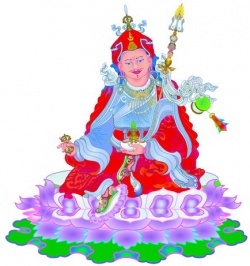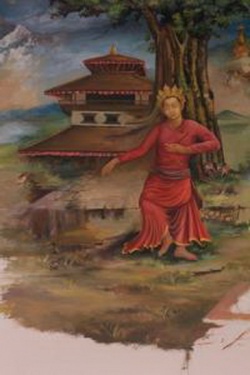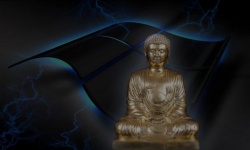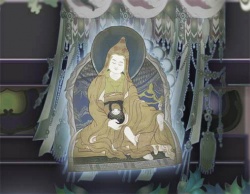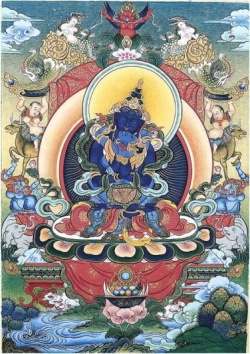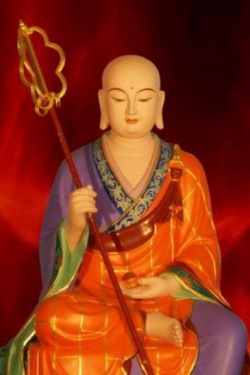Difference between revisions of "The Doctrine of Causal Connection of early Buddhism"
(Created page with " The word Dhamma in the Buddhist scriptures is used generally in four senses: (1) Scriptural texts, (2) quality (_guna_), (3) cause (_...") |
m (Text replacement - "]]]" to "]])") |
||
| (2 intermediate revisions by one other user not shown) | |||
| Line 1: | Line 1: | ||
| − | + | {{DisplayImages|2630|3687|1101|2119|1887|1972|940|1086|3692|2138}} | |
| − | |||
The [[word]] [[Dhamma]] in the [[Buddhist scriptures]] is used generally in four [[senses]]: | The [[word]] [[Dhamma]] in the [[Buddhist scriptures]] is used generally in four [[senses]]: | ||
| Line 10: | Line 9: | ||
(3) [[cause]] (_[[hetu]]_) and | (3) [[cause]] (_[[hetu]]_) and | ||
| − | (4) unsubstantial and soulless ( | + | (4) unsubstantial and soulless (_[[nissatta nijjiva]]_ [Footnote ref 103]). |
| Line 19: | Line 18: | ||
The question arises that if there is no [[substance]] or [[reality]] how are we to account for the [[phenomena]]? | The question arises that if there is no [[substance]] or [[reality]] how are we to account for the [[phenomena]]? | ||
| − | But the [[phenomena]] are happening and passing away and the main point of [[interest]] with the [[Buddha]] was to find out "What being what else is," "What happening what else happens" and "What not being what else is not." | + | But the [[phenomena]] are happening and passing away and the main point of [[interest]] with the [[Buddha]] was to find out |
| + | |||
| + | |||
| + | |||
| + | "What being what else is," | ||
| + | |||
| + | "What happening what else happens" and | ||
| + | |||
| + | "What not being what else is not." | ||
| + | |||
| + | |||
The [[phenomena]] are happening in a series and we see that there being certain [[phenomena]] there become some others; by the happening of some events others also are produced. | The [[phenomena]] are happening in a series and we see that there being certain [[phenomena]] there become some others; by the happening of some events others also are produced. | ||
| − | This is called (_[[paticca-samuppada]]_) [[dependent origination]]. But it is difficult to understand what is the exact [[nature]] of this [[dependence]]. | + | This is called (_[[paticca-samuppada]]_) [[dependent origination]]. |
| + | |||
| + | But it is difficult to understand what is the exact [[nature]] of this [[dependence]]. | ||
| + | |||
| + | The question as _[[Samyutta Nikaya]]_ (II. 5) has it with which the [[Buddha]] started before [[attaining Buddhahood]] was this: | ||
| − | + | in what [[miserable]] [[condition]] are the [[people]]! they are born, they [[decay]], they [[die]], pass away and are born again; and they do not know the [[path]] of escape from this [[decay]], [[death]] and [[misery]]. | |
How to know the Way to escape from this [[misery]] of [[decay]] and [[death]]. | How to know the Way to escape from this [[misery]] of [[decay]] and [[death]]. | ||
| − | Then it occurred to him what being there, are [[decay]] and [[death]], depending on what do they come? As he [[thought]] deeply into the [[root]] of the {{Wiki|matter}}, it occurred to him that [[decay]] and [[death]] can only occur when there is [[birth]] (_[[jati]]_), so they | + | Then it occurred to him what being there, are [[decay]] and [[death]], depending on what do they come? |
| + | |||
| + | As he [[thought]] deeply into the [[root]] of the {{Wiki|matter}}, it occurred to him that [[decay]] and [[death]] can only occur when there is [[birth]] (_[[jati]]_), so they depend on [[birth]]. | ||
| + | |||
| + | What being there, is there [[birth]], on what does [[birth]] depend? | ||
Then it occurred to him that [[birth]] could only be if there were previous [[existence]] (_[[bhava]]_) [Footnote ref 104]. | Then it occurred to him that [[birth]] could only be if there were previous [[existence]] (_[[bhava]]_) [Footnote ref 104]. | ||
| Line 41: | Line 58: | ||
To this it occurred to him that there must be a sense-contact (_[[phassa]]_) in order that there may be [[feeling]] [Footnote ref 107]. If there should be no sense-contact there would be no [[feeling]]. | To this it occurred to him that there must be a sense-contact (_[[phassa]]_) in order that there may be [[feeling]] [Footnote ref 107]. If there should be no sense-contact there would be no [[feeling]]. | ||
| − | But on what does sense-contact depend? It occurred to him that as there are six sense-contacts, there are the six fields of [[contact]] (_[[ayatana]]_) [Footnote ref [[108]] | + | But on what does sense-contact depend? It occurred to him that as there are six sense-contacts, there are the six fields of [[contact]] (_[[ayatana]]_) [Footnote ref [[108]]). |
But on what do the six [[ayatanas]] depend? It occurred to him that there must be the [[mind and body]] (_[[namarupa]]_) in order that there may be the six fields of [[contact]] [Footnote ref 109]; but on what does [[namarupa]] depend? It occurred to him that without [[consciousness]] (_[[vinnana]]_) there could be no [[namarupa]] [Footnote ref 110]. | But on what do the six [[ayatanas]] depend? It occurred to him that there must be the [[mind and body]] (_[[namarupa]]_) in order that there may be the six fields of [[contact]] [Footnote ref 109]; but on what does [[namarupa]] depend? It occurred to him that without [[consciousness]] (_[[vinnana]]_) there could be no [[namarupa]] [Footnote ref 110]. | ||
| Line 50: | Line 67: | ||
| − | It is indeed difficult to be definite as to what the [[Buddha]] actually wished to mean by this cycle of [[dependence]] of [[existence]] sometimes called [[Bhavacakra]] ([[wheel of existence]]). [[Decay]] and [[death]] (_[[jaramarana]]_) could not have happened if there was no [[birth]] [Footnote ref 113]. | + | It is indeed difficult to be definite as to what the [[Buddha]] actually wished to mean by this cycle of [[dependence]] of [[existence]] sometimes called [[Bhavacakra]] ([[wheel of existence]]). |
| + | |||
| + | [[Decay]] and [[death]] (_[[jaramarana]]_) could not have happened if there was no [[birth]] [Footnote ref 113]. | ||
This seems to be clear. But at this point the difficulty begins. We must remember that the {{Wiki|theory}} of [[rebirth]] wasenunciated in the [[Upanisads]]. | This seems to be clear. But at this point the difficulty begins. We must remember that the {{Wiki|theory}} of [[rebirth]] wasenunciated in the [[Upanisads]]. | ||
| Line 58: | Line 77: | ||
This [[life]] thus presupposes another [[existence]]. | This [[life]] thus presupposes another [[existence]]. | ||
| − | So far as I remember there has seldom been before or after [[Buddha]] any serious attempt to prove or disprove the [[doctrine]] of [[rebirth]] [Footnote ref 114]. All schools of [[philosophy]] except the [[Carvakas]] believed in it and so little is known to us of the [[Carvaka | + | So far as I remember there has seldom been before or after [[Buddha]] any serious attempt to prove or disprove the [[doctrine]] of [[rebirth]] [Footnote ref 114]. All schools of [[philosophy]] except the [[Carvakas]] believed in it and so little is known to us of the [[Carvaka sutras]] that it is difficult to say what they did to refute this [[doctrine]]. |
| Line 68: | Line 87: | ||
It was strongly believed by all [[people]], and the [[Buddha]] also, when he came to think to what our {{Wiki|present}} [[birth]] might be due, had to fall back upon another [[existence]] (_[[bhava]]_). | It was strongly believed by all [[people]], and the [[Buddha]] also, when he came to think to what our {{Wiki|present}} [[birth]] might be due, had to fall back upon another [[existence]] (_[[bhava]]_). | ||
| − | If [[bhava]] means [[karma]] which brings [[rebirth]] as | + | If [[bhava]] means [[karma]] which brings [[rebirth]] as [[Candrakirti]] takes it to mean, then it would mean that the {{Wiki|present}} [[birth]] could only take place on account of the works of a previous [[existence]] which determined it. Here also we are reminded of the [[Upanisad]] note "as a man does so will he be born" (_Yat [[karma]] kurute tadabhisampadyate_, Brh IV. iv. 5). |
| − | Candrakirtti's [[interpretation]] of "[[bhava]]" as [[Karma]] ( | + | [[Candrakirtti's]] [[interpretation]] of "[[bhava]]" as [[Karma]] (_[[punarbhavajanakam karma]]_) seems to me to suit better than "[[existence]]." |
The [[word]] was probably used rather loosely for _[[kammabhava]]_. The [[word]] [[bhava]] is not found in the earlier [[Upanisads]] and was used in the [[Pali scriptures]] for the first time as a [[philosophical]] term. | The [[word]] was probably used rather loosely for _[[kammabhava]]_. The [[word]] [[bhava]] is not found in the earlier [[Upanisads]] and was used in the [[Pali scriptures]] for the first time as a [[philosophical]] term. | ||
| Line 78: | Line 97: | ||
| − | "whatever one betakes himself to, so does he work" ( | + | "whatever one betakes himself to, so does he work" (_[[Yatkraturbhavati tatkarmma kurute]]_, Brh. IV. iv. 5). As this betaking to the thing depends upon [[desire]] {_[[trsna]]_}, it is said that in order that there may be [[upadana]] there must be [[tanha]]. In the [[Upanisads]] also we read "Whatever one [[desires]] so does he betake himself to" (_[[sa yathakamo bhavati tatkraturbhavati]]_). |
Neither the [[word]] [[upadana]] nor [[trsna]] (the [[Sanskrit]] [[word]] correspondingto [[tanha]]) is found in the earlier [[Upanisads]], but the [[ideas]] contained in them are similar to the words "_kratu_" and "_[[kama]]_." | Neither the [[word]] [[upadana]] nor [[trsna]] (the [[Sanskrit]] [[word]] correspondingto [[tanha]]) is found in the earlier [[Upanisads]], but the [[ideas]] contained in them are similar to the words "_kratu_" and "_[[kama]]_." | ||
| − | [[Desire]] ([[tanha]]) is then said to depend on [[feeling]] or sense-contact. Sense-contact presupposes the [[six senses]] as fields of operation [Footnote ref 115]. | + | [[Desire]] ([[tanha]]) is then said to depend on [[feeling]] or [[sense-contact]]. |
| + | |||
| + | [[Sense-contact]] presupposes the [[six senses]] as fields of operation [Footnote ref 115]. | ||
These [[six senses]] or operating fields would again presuppose the whole psychosis of the man (the [[body]] and the [[mind]] together) called [[namarupa]]. | These [[six senses]] or operating fields would again presuppose the whole psychosis of the man (the [[body]] and the [[mind]] together) called [[namarupa]]. | ||
| Line 94: | Line 115: | ||
He further says that [[name]] by itself can produce [[physical]] changes, such as eating, drinking, making movements or the like. | He further says that [[name]] by itself can produce [[physical]] changes, such as eating, drinking, making movements or the like. | ||
| − | So [[form]] also cannot produce any of those changes by itself. But like the cripple and the [[blind]] they mutually help one another and effectuate the changes [Footnote ref 118]. | + | So [[form]] also cannot produce any of those changes by itself. |
| + | |||
| + | But like the cripple and the [[blind]] they mutually help one another and effectuate the changes [Footnote ref 118]. | ||
But there [[exists]] no heap or collection of material for the production of [[Name]] and [[Form]]; | But there [[exists]] no heap or collection of material for the production of [[Name]] and [[Form]]; | ||
| − | "but just as when a lute is played upon, there is no previous store of [[sound]]; and when the [[sound]] comes into [[existence]] it does not come from any such store; and when it ceases, it does not go to any of the cardinal or [[intermediate]] points of the compass;...in exactly the same way all the [[elements]] of being both those with [[form]] and those without, come into [[existence]] after having previously been [[non-existent]] and having come into [[existence]] pass away [Footnote ref 119]." | + | |
| + | |||
| + | "but just as when a lute is played upon, there is no previous store of [[sound]]; | ||
| + | |||
| + | and when the [[sound]] comes into [[existence]] it does not come from any such store; and when it ceases, it does not go to any of the cardinal or [[intermediate]] points of the {{Wiki|compass}};... | ||
| + | |||
| + | in exactly the same way all the [[elements]] of being both those with [[form]] and those without, come into [[existence]] after having previously been [[non-existent]] and having come into [[existence]] pass away [Footnote ref 119]." | ||
[[Namarupa]] taken in this [[sense]] will not mean the whole of [[mind and body]], but only the [[sense]] functions and the [[body]] which are found to operate in the [[six doors]] of [[sense]] (_[[salayatana]]_). | [[Namarupa]] taken in this [[sense]] will not mean the whole of [[mind and body]], but only the [[sense]] functions and the [[body]] which are found to operate in the [[six doors]] of [[sense]] (_[[salayatana]]_). | ||
| + | |||
| + | |||
If we take [[namarupa]] in this [[sense]], we can see that it may be said to depend upon the [[vinnana]] ([[consciousness]]). | If we take [[namarupa]] in this [[sense]], we can see that it may be said to depend upon the [[vinnana]] ([[consciousness]]). | ||
| Line 111: | Line 142: | ||
| − | If we are to define its [[characteristics]] we must say that it [[knows]] (_[[vijanana]]_), goes in advance ( | + | If we are to define its [[characteristics]] we must say that it [[knows]] (_[[vijanana]]_), goes in advance (_[[pubbangama]]_), connects (_[[sandhana]]_), and stands on [[namarupa]] (_[[namarupapadatthanam]]_). |
| − | When the [[consciousness]] gets a door, at a place the [[objects]] of [[sense]] are discerned ( | + | When the [[consciousness]] gets a door, at a place the [[objects]] of [[sense]] are discerned (_[[arammana-vibhavanatthane]]_) and it goes first as the precursor. |
When a [[visual object]] is seen by the [[eye]] it is known only by the [[consciousness]], and when the [[dhammas]] are made the [[objects]] of ([[mind]]) [[mano]], it is known only by the [[consciousness]] [Footnote ref 121]. [[Buddhaghosa]] also refers here to the passage in the _[[Milinda Panha]]_ we have just referred to. | When a [[visual object]] is seen by the [[eye]] it is known only by the [[consciousness]], and when the [[dhammas]] are made the [[objects]] of ([[mind]]) [[mano]], it is known only by the [[consciousness]] [Footnote ref 121]. [[Buddhaghosa]] also refers here to the passage in the _[[Milinda Panha]]_ we have just referred to. | ||
| Line 137: | Line 168: | ||
[[Jati]] is the [[appearance]] of the [[body]] or the {{Wiki|totality}} of the [[five skandhas]] [Footnote ref 123]. | [[Jati]] is the [[appearance]] of the [[body]] or the {{Wiki|totality}} of the [[five skandhas]] [Footnote ref 123]. | ||
| − | Coming to [[bhava]] which determines [[jati]], I cannot think of any better [[rational]] explanation of [[bhava]], than that I have | + | Coming to [[bhava]] which determines [[jati]], I cannot think of any better [[rational]] explanation of [[bhava]], than that I have already suggested, namely, the works (_[[karma]]_) which produce the [[birth]] [Footnote ref 124]. |
| + | |||
| + | [[Upadana]] is an advanced [[trsna]] leading to positive [[clinging]] [Footnote ref 125]. | ||
It is produced by [[trsna]] ([[desire]]) which again is the result of [[vedana]] ([[pleasure]] and [[pain]]). | It is produced by [[trsna]] ([[desire]]) which again is the result of [[vedana]] ([[pleasure]] and [[pain]]). | ||
| Line 143: | Line 176: | ||
But this [[vedana]] is of course [[vedana]] with [[ignorance]] (_[[avidya]]_), for an [[Arhat]] may have also [[vedana]] but as he has no [[avidya]], the [[vedana]] cannot produce [[trsna]] in turn. | But this [[vedana]] is of course [[vedana]] with [[ignorance]] (_[[avidya]]_), for an [[Arhat]] may have also [[vedana]] but as he has no [[avidya]], the [[vedana]] cannot produce [[trsna]] in turn. | ||
| − | On its [[development]] it immediately passes into [[upadana]]. [[Vedana]] means [[pleasurable]], [[painful]] or indifferent [[feeling]]. On the one side it leads to [[trsna]] ([[desire]]) and on the other it is produced by sense-contact (_spars'a_). | + | On its [[development]] it immediately passes into [[upadana]]. |
| + | |||
| + | [[Vedana]] means [[pleasurable]], [[painful]] or indifferent [[feeling]]. On the one side it leads to [[trsna]] ([[desire]]) and on the other it is produced by sense-contact (_spars'a_). | ||
| + | |||
| + | Prof. De la Vallee [[Wikipedia:Louis de La Vallée-Poussin|Poussin]] says that [[S'rilabha]] distinguishes three {{Wiki|processes}} in the production of [[vedana]]. | ||
| − | |||
| + | Thus first there is the [[contact]] between the [[sense]] and the [[object]]; then there is the [[knowledge]] of the [[object]], and then there is the [[vedana]]. | ||
| − | + | Depending on _[[Majjhima Nikaya]]_, iii. 242, | |
| − | [[Wikipedia:Louis de La Vallée-Poussin|Poussin]] gives the other opinion that just as in the case of two sticks heat takes place simultaneously with rubbing, so here also [[vedana]] takes place simultaneously with spars'a for they are "produits par un meme complexe de [[causes]] ( | + | [[Wikipedia:Louis de La Vallée-Poussin|Poussin]] gives the other opinion that just as in the case of two sticks heat takes place simultaneously with rubbing, so here also [[vedana]] takes place simultaneously with [[spars'a]] for they are "produits par un meme complexe de [[causes]] (_[[samagri]]_) [Footnote ref 126]." |
| − | Spars'a is produced by [[sadayatana]], [[sadayatana]] by [[namarupa]], and [[namarupa]] by [[vijnana]], and is said to descend in the [[womb]] of the mother and produce the [[five skandhas]] as [[namarupa]], out of which the [[six senses]] are specialized. | + | [[Spars'a]] is produced by [[sadayatana]], [[sadayatana]] by [[namarupa]], and [[namarupa]] by [[vijnana]], and is said to descend in the [[womb]] of the mother and produce the [[five skandhas]] as [[namarupa]], out of which the [[six senses]] are specialized. |
[[Vijnana]] in this connection probably means the [[principle]] or germ of [[consciousness]] in the [[womb]] of the mother upholding the [[five elements]] of the new [[body]] there. It is the product of the {{Wiki|past}} [[karmas]] (_[[sankhara]]_) of the dying man and of his {{Wiki|past}} [[consciousness]] too. | [[Vijnana]] in this connection probably means the [[principle]] or germ of [[consciousness]] in the [[womb]] of the mother upholding the [[five elements]] of the new [[body]] there. It is the product of the {{Wiki|past}} [[karmas]] (_[[sankhara]]_) of the dying man and of his {{Wiki|past}} [[consciousness]] too. | ||
| Line 175: | Line 212: | ||
| − | The [[vijnana]] is indeed a direct product of the [[samskaras]] and the sort of [[birth]] in which [[vijnana]] should bring down ( | + | The [[vijnana]] is indeed a direct product of the [[samskaras]] and the sort of [[birth]] in which [[vijnana]] should bring down (_[[namayati]]_) the new [[existence]] (_[[upapatti]]_) is determined by the [[samskaras]] [Footnote ref 127], |
| − | for in [[reality]] the happening of [[death]] ( | + | for in [[reality]] the happening of [[death]] (_[[maranabhava]]_) and the instillation of the [[vijnana]] as the beginning of the new [[life]] (_[[upapattibhava]]_) cannot be simultaneous, but the [[latter]] succeeds just at the next [[moment]], and it is to signify this close succession that they are said to be simultaneous. |
If the [[vijnana]] had not entered the [[womb]] then no [[namarupa]] could have appeared [Footnote ref 128]. | If the [[vijnana]] had not entered the [[womb]] then no [[namarupa]] could have appeared [Footnote ref 128]. | ||
| − | This chain of [[twelve causes]] extends over [[three lives]]. Thus [[avidya]] and [[samskara]] of the [[past life]] produce the [[vijnana]], namarupa,sadayatana, spars'a, [[vedana]], [[trsna]], [[upadana]] and the [[bhava]] (leading to another [[life]]) of the {{Wiki|present}} actual [[life] | + | This chain of [[twelve causes]] extends over [[three lives]]. Thus [[avidya]] and [[samskara]] of the [[past life]] produce the [[vijnana]], [[namarupa]],[[sadayatana]], [[spars'a]], [[vedana]], [[trsna]], [[upadana]] and the [[bhava]] (leading to another [[life]]) of the {{Wiki|present}} actual [[life]]. |
| − | It is [[interesting]] to note that these [[twelve links]] in the chain extending in three [[sections]] over [[three lives]] are all but the [[manifestations]] of [[sorrow]] to the bringing in of which they naturally determine one another. Thus _[[Abhidhammatthasangaha]]_ says "each of these twelve terms is a factor. | + | This [[bhava]] produces the [[jati]] and [[jaramarana]] of the next [[life]] [Footnote ref 129]. |
| + | |||
| + | It is [[interesting]] to note that these [[twelve links]] in the chain extending in three [[sections]] over [[three lives]] are all but the [[manifestations]] of [[sorrow]] to the bringing in of which they naturally determine one another. | ||
| + | |||
| + | Thus _[[Abhidhammatthasangaha]]_ says "each of these twelve terms is a factor. | ||
For the composite term '[[sorrow]],' etc. is only meant to show incidental {{Wiki|consequences}} of [[birth]]. Again when '[[ignorance]]' and 'the [[actions]] of the [[mind]]' have been taken into account, [[craving]] (_[[trsna]]_), [[grasping]] (_[[upadana]]_) and (_[[karma]]_) becoming (_[[bhava]]_) are implicitly accounted for also. | For the composite term '[[sorrow]],' etc. is only meant to show incidental {{Wiki|consequences}} of [[birth]]. Again when '[[ignorance]]' and 'the [[actions]] of the [[mind]]' have been taken into account, [[craving]] (_[[trsna]]_), [[grasping]] (_[[upadana]]_) and (_[[karma]]_) becoming (_[[bhava]]_) are implicitly accounted for also. | ||
| Line 217: | Line 258: | ||
| − | These twelve [[interdependent]] links ( | + | These twelve [[interdependent]] links (_[[dvadas'anga]]_) represent the [[paticcasamuppada]] (_[[pratatyasamutpada]]_) [[doctrines]] ([[dependent origination]]) [Footnote ref 131] which are themselves but [[sorrow]] and lead to cycles of [[sorrow]]. |
| − | [[Samutpada]] means [[appearance]] or [[arising]] ( | + | The term [[paticcasamuppada]] or [[pratityasamutpada]] has been differently interpreted in later [[Buddhist literature]] [Footnote ref 132]. |
| + | |||
| + | [[Samutpada]] means [[appearance]] or [[arising]] (_[[pradurbhdava]]_) and [[pratitya]] means after getting (_prati+i+ya_); combining the two we find, [[arising]] after getting (something). | ||
The [[elements]], depending on which there is some kind of [[arising]], are called [[hetu]] ([[cause]]) and [[paccaya]] (ground). | The [[elements]], depending on which there is some kind of [[arising]], are called [[hetu]] ([[cause]]) and [[paccaya]] (ground). | ||
| − | These two words however are often used in the same [[sense]] and are interchangeable. But [[paccaya]] is also used in a specific [[sense]]. | + | These two words however are often used in the same [[sense]] and are interchangeable. |
| + | |||
| + | But [[paccaya]] is also used in a specific [[sense]]. | ||
| − | Thus when it is said that [[avijja]] is the [[paccaya]] of [[sankhara]] it is meant that [[avijja]] is the ground (_[[thiti]]_) of the origin of the [[sankharas]], is the ground of their {{Wiki|movement}}, of the instrument through which they stand ( | + | Thus when it is said that [[avijja]] is the [[paccaya]] of [[sankhara]] it is meant that [[avijja]] is the ground (_[[thiti]]_) of the origin of the [[sankharas]], is the ground of their {{Wiki|movement}}, of the instrument through which they stand (_[[nimittatthiti]]_), of their [[ayuhana]] (conglomeration), of their interconnection, of their intelligibility, of their conjoint [[arising]], of their function as [[cause]] and of their function as the ground with reference to those which are determined by them. |
[[Avijja]] in all these nine ways is the ground of [[sankhara]] both in the {{Wiki|past}} and also in the {{Wiki|future}}, though [[avijja]] itself is determined in its turn by other grounds [Footnote ref 133]. | [[Avijja]] in all these nine ways is the ground of [[sankhara]] both in the {{Wiki|past}} and also in the {{Wiki|future}}, though [[avijja]] itself is determined in its turn by other grounds [Footnote ref 133]. | ||
Latest revision as of 22:42, 4 April 2016
The word Dhamma in the Buddhist scriptures is used generally in four senses:
(1) Scriptural texts,
(4) unsubstantial and soulless (_nissatta nijjiva_ [Footnote ref 103]).
Of these it is the last meaning which is particularly important, from the point of view of Buddhist philosophy.
The early Buddhist philosophy did not accept any fixed entity as determining all reality; the only things with it were the unsubstantial phenomena and these were called dhammas.
The question arises that if there is no substance or reality how are we to account for the phenomena?
But the phenomena are happening and passing away and the main point of interest with the Buddha was to find out
"What being what else is,"
"What happening what else happens" and
"What not being what else is not."
The phenomena are happening in a series and we see that there being certain phenomena there become some others; by the happening of some events others also are produced.
This is called (_paticca-samuppada_) dependent origination.
But it is difficult to understand what is the exact nature of this dependence.
The question as _Samyutta Nikaya_ (II. 5) has it with which the Buddha started before attaining Buddhahood was this:
in what miserable condition are the people! they are born, they decay, they die, pass away and are born again; and they do not know the path of escape from this decay, death and misery.
How to know the Way to escape from this misery of decay and death.
Then it occurred to him what being there, are decay and death, depending on what do they come?
As he thought deeply into the root of the matter, it occurred to him that decay and death can only occur when there is birth (_jati_), so they depend on birth.
What being there, is there birth, on what does birth depend?
Then it occurred to him that birth could only be if there were previous existence (_bhava_) [Footnote ref 104].
But on what does this existence depend, or what being there is there _bhava_. Then it occurred to him that there could not be existence unless there were holding fast (_upadana_) [Footnote ref 105].
But on what did upadana depend? It occurred to him that it was desire (_tanha_) on which upadana depended.
There can be upadana if there is desire (_tanha_) [Footnote ref 106]. But what being there, can there be desire? To this question it occurred to him that there must be feeling (_vedana_) in order that there may be desire. But on what does vedana depend, or rather what must be there, that there may be feeling (_vedana_)?
To this it occurred to him that there must be a sense-contact (_phassa_) in order that there may be feeling [Footnote ref 107]. If there should be no sense-contact there would be no feeling.
But on what does sense-contact depend? It occurred to him that as there are six sense-contacts, there are the six fields of contact (_ayatana_) [Footnote ref 108).
But on what do the six ayatanas depend? It occurred to him that there must be the mind and body (_namarupa_) in order that there may be the six fields of contact [Footnote ref 109]; but on what does namarupa depend? It occurred to him that without consciousness (_vinnana_) there could be no namarupa [Footnote ref 110].
But what being there would therebe vinnana. Here it occurred to him that in order that there might be vinnana there must be the conformations (_sankhara_) [Footnote ref 111].
But what being there are there the sankharas? Here it occurred to him that the sankharas can only be if there is ignorance (_avijja_). If avijja could be stopped then the sankharas will be stopped, and if the sankharas could be stopped vinnana could be stopped and so on [Footnote ref 112].
It is indeed difficult to be definite as to what the Buddha actually wished to mean by this cycle of dependence of existence sometimes called Bhavacakra (wheel of existence).
Decay and death (_jaramarana_) could not have happened if there was no birth [Footnote ref 113].
This seems to be clear. But at this point the difficulty begins. We must remember that the theory of rebirth wasenunciated in the Upanisads.
The Brhadaranyaka says that just as an insect going to the end of a leaf of grass by a new effort collects itself in another so does the soul coming to the end of this life collect itself in another.
This life thus presupposes another existence.
So far as I remember there has seldom been before or after Buddha any serious attempt to prove or disprove the doctrine of rebirth [Footnote ref 114]. All schools of philosophy except the Carvakas believed in it and so little is known to us of the Carvaka sutras that it is difficult to say what they did to refute this doctrine.
The Buddha also accepts it as a fact and does not criticize it.
This life therefore comes only as one which had an infinite number of lives before, and which except in the case of a few emancipated ones would have an infinite number of them in the future.
It was strongly believed by all people, and the Buddha also, when he came to think to what our present birth might be due, had to fall back upon another existence (_bhava_).
If bhava means karma which brings rebirth as Candrakirti takes it to mean, then it would mean that the present birth could only take place on account of the works of a previous existence which determined it. Here also we are reminded of the Upanisad note "as a man does so will he be born" (_Yat karma kurute tadabhisampadyate_, Brh IV. iv. 5).
Candrakirtti's interpretation of "bhava" as Karma (_punarbhavajanakam karma_) seems to me to suit better than "existence."
The word was probably used rather loosely for _kammabhava_. The word bhava is not found in the earlier Upanisads and was used in the Pali scriptures for the first time as a philosophical term.
But on what does this bhava depend? There could not have been a previous existence if people had not betaken themselves to things or works they desired. This betaking oneself to actions or things in accordance with desire is called upadana. In the Upanisads we read,
"whatever one betakes himself to, so does he work" (_Yatkraturbhavati tatkarmma kurute_, Brh. IV. iv. 5). As this betaking to the thing depends upon desire {_trsna_}, it is said that in order that there may be upadana there must be tanha. In the Upanisads also we read "Whatever one desires so does he betake himself to" (_sa yathakamo bhavati tatkraturbhavati_).
Neither the word upadana nor trsna (the Sanskrit word correspondingto tanha) is found in the earlier Upanisads, but the ideas contained in them are similar to the words "_kratu_" and "_kama_."
Desire (tanha) is then said to depend on feeling or sense-contact.
Sense-contact presupposes the six senses as fields of operation [Footnote ref 115].
These six senses or operating fields would again presuppose the whole psychosis of the man (the body and the mind together) called namarupa.
We are familiar with this word in the Upanisads but there it is used in the sense of determinate forms and names as distinguished from the indeterminate indefinable reality [Footnote ref 116].
Buddhaghosa in the _Visuddhimagga_ says that by "Name" are meant the three groups beginning with sensation (i.e. sensation, perception and the predisposition); by "Form" the four elements and form derivative from the four elements [Footnote ref 117].
He further says that name by itself can produce physical changes, such as eating, drinking, making movements or the like.
So form also cannot produce any of those changes by itself.
But like the cripple and the blind they mutually help one another and effectuate the changes [Footnote ref 118].
But there exists no heap or collection of material for the production of Name and Form;
"but just as when a lute is played upon, there is no previous store of sound;
and when the sound comes into existence it does not come from any such store; and when it ceases, it does not go to any of the cardinal or intermediate points of the compass;...
in exactly the same way all the elements of being both those with form and those without, come into existence after having previously been non-existent and having come into existence pass away [Footnote ref 119]."
Namarupa taken in this sense will not mean the whole of mind and body, but only the sense functions and the body which are found to operate in the six doors of sense (_salayatana_).
If we take namarupa in this sense, we can see that it may be said to depend upon the vinnana (consciousness).
Consciousness has been compared in the _Milinda Panha_ with a watchman at the middle ofthe cross-roads beholding all that come from any direction [Footnote ref 120].
Buddhaghosa in the _Atthasalini_ also says that consciousness means that which thinks its object.
If we are to define its characteristics we must say that it knows (_vijanana_), goes in advance (_pubbangama_), connects (_sandhana_), and stands on namarupa (_namarupapadatthanam_).
When the consciousness gets a door, at a place the objects of sense are discerned (_arammana-vibhavanatthane_) and it goes first as the precursor.
When a visual object is seen by the eye it is known only by the consciousness, and when the dhammas are made the objects of (mind) mano, it is known only by the consciousness [Footnote ref 121]. Buddhaghosa also refers here to the passage in the _Milinda Panha_ we have just referred to.
He further goes on to say that when states of consciousness rise one after another, they leave no gap between the previous state and the later and consciousness therefore appears as connected.
When there are the aggregates of the five khandhas it is lost; but there are the four aggregates as namarupa, it stands on nama and therefore it is said that it stands on namarupa.
He further asks, Is this consciousness the same as the previous consciousness or different from it?
He answers that it is the same. Just so, the sun shows itself with all its colours, etc., but he is not different from those in truth; and it is said that just when the sun rises, its collected heat and yellow colour also rise then, but it does not mean that the sun is different from these.
So the citta or consciousness takes the phenomena of contact, etc., and cognizes them.
So though it is the same as they are yet in a sense it is different from them [Footnote ref 122].
To go back to the chain of twelve causes, we find that jati (birth) is the cause of decay and death, _jaramarana_, etc.
Jati is the appearance of the body or the totality of the five skandhas [Footnote ref 123].
Coming to bhava which determines jati, I cannot think of any better rational explanation of bhava, than that I have already suggested, namely, the works (_karma_) which produce the birth [Footnote ref 124].
Upadana is an advanced trsna leading to positive clinging [Footnote ref 125].
It is produced by trsna (desire) which again is the result of vedana (pleasure and pain).
But this vedana is of course vedana with ignorance (_avidya_), for an Arhat may have also vedana but as he has no avidya, the vedana cannot produce trsna in turn.
On its development it immediately passes into upadana.
Vedana means pleasurable, painful or indifferent feeling. On the one side it leads to trsna (desire) and on the other it is produced by sense-contact (_spars'a_).
Prof. De la Vallee Poussin says that S'rilabha distinguishes three processes in the production of vedana.
Thus first there is the contact between the sense and the object; then there is the knowledge of the object, and then there is the vedana.
Depending on _Majjhima Nikaya_, iii. 242,
Poussin gives the other opinion that just as in the case of two sticks heat takes place simultaneously with rubbing, so here also vedana takes place simultaneously with spars'a for they are "produits par un meme complexe de causes (_samagri_) [Footnote ref 126]."
Spars'a is produced by sadayatana, sadayatana by namarupa, and namarupa by vijnana, and is said to descend in the womb of the mother and produce the five skandhas as namarupa, out of which the six senses are specialized.
Vijnana in this connection probably means the principle or germ of consciousness in the womb of the mother upholding the five elements of the new body there. It is the product of the past karmas (_sankhara_) of the dying man and of his past consciousness too.
We sometimes find that the Buddhists believed that the last thoughts of the dying man determined the nature of his next.
The manner in which the vijnana produced in the womb is determined by the past vijnana of the previous existence is according to some authorities of the nature of a reflected image, like the transmission of learning from the teacher to the disciple, like the lighting of a lamp from another lamp or like the impress of a stamp on wax.
As all the skandhas are changing in life, so death also is but a similar change; there is no great break, but the same uniform sort of destruction and coming into being.
New skandhas are produced as simultaneously as the two scale pans of a balance rise up and fall, in the same manner as a lamp is lighted or an image is reflected.
At the death of the man the vijnana resulting from his previous karmas and vijnanas enters into the womb of that mother (animal, man or the gods) in which the next skandhas are to be matured.
This vijnana thus forms the principle of the new life.
It is in this vijnana that name (_nama_) and form (_rupa_) become associated.
The vijnana is indeed a direct product of the samskaras and the sort of birth in which vijnana should bring down (_namayati_) the new existence (_upapatti_) is determined by the samskaras [Footnote ref 127],
for in reality the happening of death (_maranabhava_) and the instillation of the vijnana as the beginning of the new life (_upapattibhava_) cannot be simultaneous, but the latter succeeds just at the next moment, and it is to signify this close succession that they are said to be simultaneous.
If the vijnana had not entered the womb then no namarupa could have appeared [Footnote ref 128].
This chain of twelve causes extends over three lives. Thus avidya and samskara of the past life produce the vijnana, namarupa,sadayatana, spars'a, vedana, trsna, upadana and the bhava (leading to another life) of the present actual life.
This bhava produces the jati and jaramarana of the next life [Footnote ref 129].
It is interesting to note that these twelve links in the chain extending in three sections over three lives are all but the manifestations of sorrow to the bringing in of which they naturally determine one another.
Thus _Abhidhammatthasangaha_ says "each of these twelve terms is a factor.
For the composite term 'sorrow,' etc. is only meant to show incidental consequences of birth. Again when 'ignorance' and 'the actions of the mind' have been taken into account, craving (_trsna_), grasping (_upadana_) and (_karma_) becoming (_bhava_) are implicitly accounted for also.
In the same manner when craving, grasping and (_karma_) becoming have been taken into account, ignorance and the actions of the mind are (implicitly) accounted for, also; and when birth, decay, and death are taken into account, even the fivefold fruit, to wit (rebirth), consciousness, and the rest are accounted for. And thus:
Five causes in the Past and Now a fivefold 'fruit.'
Five causes Now and yet to come a fivefold 'fruit' make up the Twenty Modes, the Three Connections
and the four groups
(one causal group in the Past,
one resultant group in the Present,
one causal group in the Present and
one resultant group in the Future,
each group consisting of five modes) [Footnote ref 130]."
These twelve interdependent links (_dvadas'anga_) represent the paticcasamuppada (_pratatyasamutpada_) doctrines (dependent origination) [Footnote ref 131] which are themselves but sorrow and lead to cycles of sorrow.
The term paticcasamuppada or pratityasamutpada has been differently interpreted in later Buddhist literature [Footnote ref 132].
Samutpada means appearance or arising (_pradurbhdava_) and pratitya means after getting (_prati+i+ya_); combining the two we find, arising after getting (something).
The elements, depending on which there is some kind of arising, are called hetu (cause) and paccaya (ground).
These two words however are often used in the same sense and are interchangeable.
But paccaya is also used in a specific sense.
Thus when it is said that avijja is the paccaya of sankhara it is meant that avijja is the ground (_thiti_) of the origin of the sankharas, is the ground of their movement, of the instrument through which they stand (_nimittatthiti_), of their ayuhana (conglomeration), of their interconnection, of their intelligibility, of their conjoint arising, of their function as cause and of their function as the ground with reference to those which are determined by them.
Avijja in all these nine ways is the ground of sankhara both in the past and also in the future, though avijja itself is determined in its turn by other grounds [Footnote ref 133].
When we take the betu aspect of the causal chain, we cannot think of anything else but succession, but when we take the paccaya aspect we can have a better vision into the nature of the cause as ground.
Thus when avijja is said to be the ground of the sankharas in the nine ways mentioned above, it seems reasonable to think that the sankharas were in some sense regarded as special manifestations of avijja [Footnote ref 134].
But as this point was not further developed in the early Buddhist texts it would be unwise to proceed further with it.


